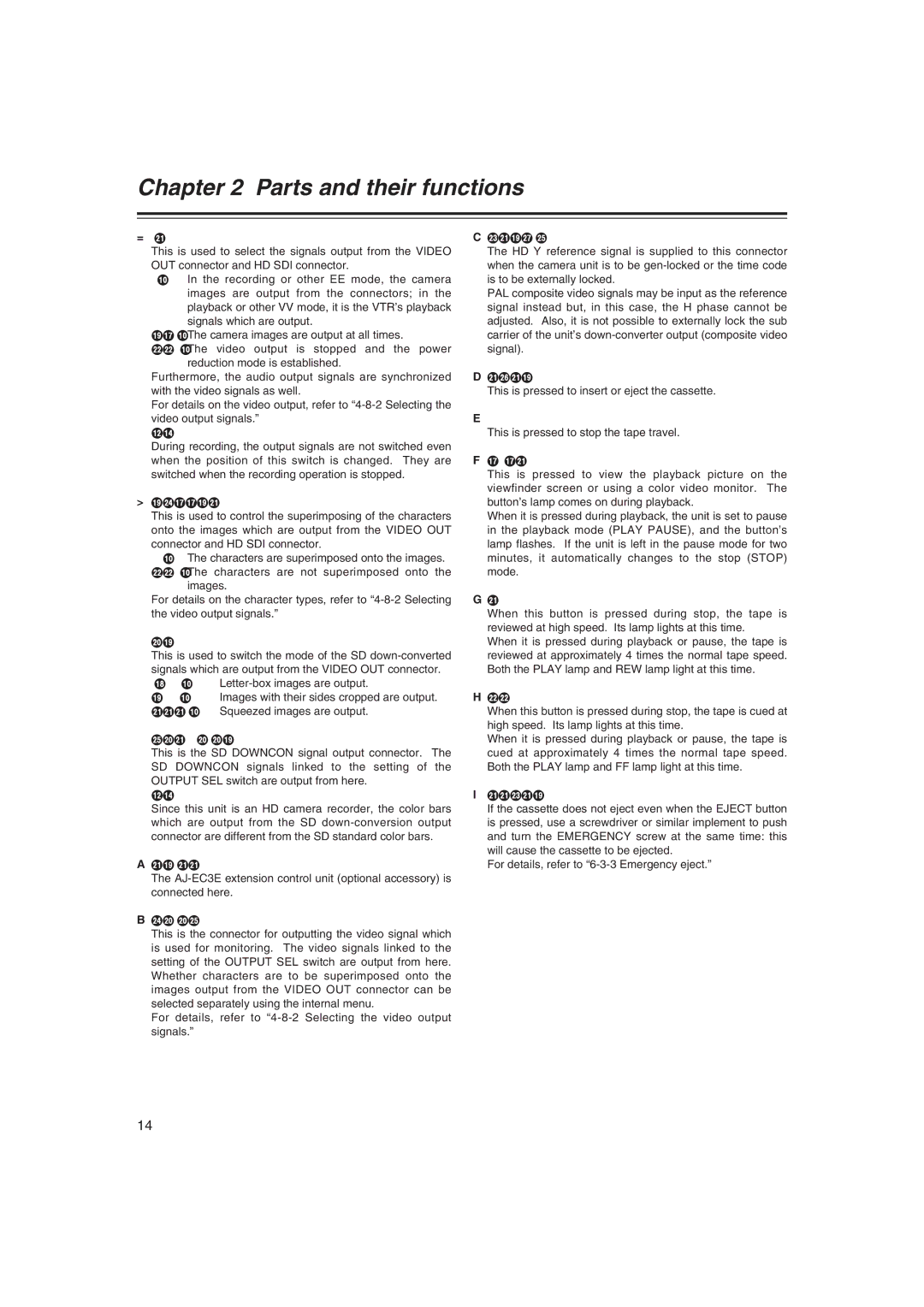
Chapter 2 Parts and their functions
=OUTPUT SEL (output signal selection) switch
This is used to select the signals output from the VIDEO OUT connector and HD SDI connector.
VTR : In the recording or other EE mode, the camera images are output from the connectors; in the playback or other VV mode, it is the VTR’s playback signals which are output.
CAM : The camera images are output at all times.
OFF : The video output is stopped and the power reduction mode is established.
Furthermore, the audio output signals are synchronized with the video signals as well.
For details on the video output, refer to
<Note>
During recording, the output signals are not switched even when the position of this switch is changed. They are switched when the recording operation is stopped.
>CHARACTER switch
This is used to control the superimposing of the characters onto the images which are output from the VIDEO OUT
connector and HD SDI connector.
ON : The characters are superimposed onto the images.
OFF : The characters are not superimposed onto the images.
For details on the character types, refer to
?DOWNCON switch
This is used to switch the mode of the SD
signals which are output from the VIDEO OUT connector.
LT BOX | : | |
SCROP | : | Images with their sides cropped are output. |
SQUEEZE : | Squeezed images are output. | |
@VIDEO OUT (SD DOWNCON signal output) connector This is the SD DOWNCON signal output connector. The SD DOWNCON signals linked to the setting of the OUTPUT SEL switch are output from here.
<Note>
Since this unit is an HD camera recorder, the color bars which are output from the SD
A ECU REMOTE (remote control) connector
The
B HD SDI (video and audio) connector
This is the connector for outputting the video signal which is used for monitoring. The video signals linked to the setting of the OUTPUT SEL switch are output from here. Whether characters are to be superimposed onto the images output from the VIDEO OUT connector can be selected separately using the internal menu.
For details, refer to
C GENLOCK IN connector
The HD Y reference signal is supplied to this connector when the camera unit is to be
PAL composite video signals may be input as the reference signal instead but, in this case, the H phase cannot be adjusted. Also, it is not possible to externally lock the sub carrier of the unit’s
D EJECT button
This is pressed to insert or eject the cassette.
E STOP button
This is pressed to stop the tape travel.
F PLAY/PAUSE button
This is pressed to view the playback picture on the viewfinder screen or using a color video monitor. The button’s lamp comes on during playback.
When it is pressed during playback, the unit is set to pause in the playback mode (PLAY PAUSE), and the button’s lamp flashes. If the unit is left in the pause mode for two minutes, it automatically changes to the stop (STOP) mode.
G REW (rewind) button and lamp
When this button is pressed during stop, the tape is reviewed at high speed. Its lamp lights at this time.
When it is pressed during playback or pause, the tape is reviewed at approximately 4 times the normal tape speed. Both the PLAY lamp and REW lamp light at this time.
H FF (fast forward) button and lamp
When this button is pressed during stop, the tape is cued at high speed. Its lamp lights at this time.
When it is pressed during playback or pause, the tape is cued at approximately 4 times the normal tape speed. Both the PLAY lamp and FF lamp light at this time.
I EMERGENCY screw (inside rubber cap)
If the cassette does not eject even when the EJECT button is pressed, use a screwdriver or similar implement to push and turn the EMERGENCY screw at the same time: this will cause the cassette to be ejected.
For details, refer to
14
